Pump up the volume
Romania's largest foreign investor, oil firm OMV, is looking to strengthen its leading position in the oil and gas field in south-eastern Europe. Corina Mica reports
Romania's biggest integrated oil and gas company, Petrom, a member of the OMV Group, last month announced investments worth almost three billion Euro in both its upstream and downstream businesses by 2010.
This would allow the company to grow into the largest oil and gas producer in south-eastern Europe.
“We want to strengthen the company so that by 2010 it dominates the integrated oil and gas business in this region,” says Wolfgang Ruttenstorfer, CEO of OMV Group and chairman of the board at Petrom.
Exploration and production (E&P) activities are the backbone of this strategy and the oil firm intends to reach a production capacity of 210,000 boe (barrels of oil equivalent) per day.
Ruttenstorfer says that the group must prepare for the oil price to fall, which means the firm needs to increase its reserves replacement rate from the current ten to 15 per cent up to 70 per cent. Petrom will need investments of 100 million Euro per year to reach this target.
In the upstream segment, 1.5 billion Euro needs to be invested to keep the production at a minimum of 210,000 boe/day.
“We have to upgrade both refineries we own and investments of one billion Euro will be made by 2010 in refineries Arpechim, Arges county and Petrobrazi, Prahova county,” Ruttenstorfer adds.
Investments in upstream and downstream together amount to three billion Euro: a figure more than OMV initially anticipated.
In gas, the aim is to sell seven billion cubic meters (bcm) by 2010. This is more that Petrom can produce, which means the company will start to be active in gas trading, aiming to attain a market share of more than 35 per cent locally.
The biggest challenge in trying to reach these goals by 2010 is the lack of qualified professionals, says Ruttenstorfer. “We are training more Romanian managers to be able to act as international managers for the group, in the Black Sea and Caspian region as well as other countries,” he adds.
At present, Petrom has a market share of 35 per cent in Romania in the oil and gas market. Petrom CEO Gheorghe Constantinescu tells The Diplomat that, beyond Romania's borders, Petrom will develop a competitive export position and supply retail markets in Bulgaria and Serbia.
This will include a massive marketing drive, with a total investment in this sector of up to 500 million Euro between 2006 and 2010.
EVERYTHING MUST GO
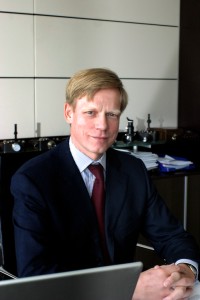 Going private this year are the final two state banks and Austrian financial institutions are ready with their cheque books.
Going private this year are the final two state banks and Austrian financial institutions are ready with their cheque books.
Romania's third largest bank is Austrian.
But such a ranking could change should Raiffeisen succeed in its newest endeavour a bid for Romania's Savings Bank, CEC.
Raiffeisen Bank Romania's president and CEO, Steven van Groningen, tells The Diplomat the local banking system is on the way to becoming mature.
“I believe there will be about five years more until things get clear,” he says. Before this, Raiffeisen wants to strengthen its local presence, so a takeover could be imminent.
“CEC is very suitable because it matches Raiffeisen's interests,” says the president. “BCR is too big and the truth is that it is good to be big, but not that big. CEC can be adaptable, and it does not need that much investment in infrastructure. It addresses the large population and rural clients who have plenty of money: the bank can reach this market with a combination of a large network and small investments in each branch. We can use CEC's infrastructure combined with Raiffeisen's volume.”
Raiffeisen Bank started to operate as a commercial bank in Romania in 1998 and in 2001 bought state bank Banca Agricola, which was close to liquidation, for 15 million Euro cash and a 45 million Euro share capital increase.
“When we took Banca Agricola over, it had 17 million Euro annual losses and a market share of about three per cent. Right now we have a market share of nine per cent,” says van Groningen.
Although running a universal bank, which provides retail and corporate services, the CEO adds that he does not want to offer all things to all people, saying that the bank positions itself as supplying quality services to people with medium to high incomes.
Currently the bank has 210 units in Romania and its total investment stands at about 200 million Euro.
BIDDING TWICE
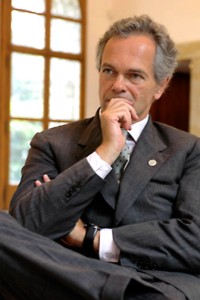 Another contender in the race for CEC is new kid on the block, Austria's Erste Bank, a financial institution with an aggressive policy on the nascent east European market.
Another contender in the race for CEC is new kid on the block, Austria's Erste Bank, a financial institution with an aggressive policy on the nascent east European market.
The bank has also made a bid for BCR.
Since 1997 the bank acquired two banks in Hungary, four in Croatia, one bank in the Czech Republic, another in Slovakia and, this July, Novosadska Banka in Serbia.
This, though, is just the beginning.
Andreas Treichl, Erste Bank's chairman of the managing board, tells The Diplomat: “Both BCR and CEC correspond to the profile drawn up by Erste Bank.” BCR has a portfolio structure close to that of Erste Bank, which is 60 per cent lending to SMEs and large corporations, 30 per cent retail lending and ten per cent municipality financing, according to Treichl.
CEC meanwhile offers a large network.
“Erste Bank has both the financial power to offer a satisfying price and the experience and relations necessary in this region to provide a more profitable business plan than that of the other competitors,” claims Treichl. “We do follow what's going on in the whole CEE region, including the Ukrainian market, but there are currently no other concrete targets - we are fully focused on Romania.”
FAST CASH
With experience of just one year of local activity, Porsche Bank supports the development of the Porsche Group's dealer network and finances its customers' purchase of cars produced by the Volkswagen Group.
 Many parameters have changed, says president Gunter Konig, since the bank started operations in November 2004, such as the exchange rate and laws concerning credits.
Many parameters have changed, says president Gunter Konig, since the bank started operations in November 2004, such as the exchange rate and laws concerning credits.
“The central bank (BNR) moved very fast and that gave us lots of homework to do,” he says.
Konig has seen “a huge demand” from customers, which has lead to strong development for the Porsche Group.
“Credit development takes time and the country now shows a bigger demand for leasing than credits for cars,” he adds.
Porsche Bank is present in eight central and eastern European countries, under the concept of having all one needs to purchase a car under one roof: vehicles, financing and dealership for Volkswagen brands.
Konig says 11 per cent of its clients are private consumers and 89 per cent companies.
The people have the potential to drive Romania into becoming the car capital of central and eastern Europe, says the president. In 1998 the Porsche Group dealers had sold 71 cars. Last year this rose to 10,500 cars. Porsche Leasing also ranked first in the leasing companies in Romania in 2004
Confusing legislation can however be an impediment to growth.
“Sometimes I have the feeling the whole law making process should be improved. There are examples when laws are adopted, but not the norms, and until these come into force, problems arise. Speed kills and sometimes laws in Romania are too fast,” Konig adds
HOUSE PROUD
Young, medium income customers in their thousands have been checking into the year-old Raiffeisen Banca pentru Locuinte (RBL) to help get finance to modernise their houses and apartments.
Romania's pioneering housing savings and crediting bank is resident in 170 Raiffeisen branches around the country and last year signed the first private public partnership with Posta Romana where, in some post offices, it set up small RBL outlets to promote its services.
The bank closed about 43,000 contracts in its first year, with an average contract worth 5,200 Euro.
Over 80 per cent of RBL's clients come from the low to medium incomes segment, RBL general manager Ionut Costea tells The Diplomat. They are aged 26 to 40 years and are looking to modernise existing lodgings rather than buy new houses.
But the tailor-made bank is not alone.
Competition appeared this year in the form of HVB Banca pentru Locuinte, an institution offering similar products and launched by competitor HVB Romania.
Let battle commence.
“The products offered by the two banks are similar,” says Costea, “and from what we have observed so far, the differences may appear in the way they are sold. But what it really is important is the fact that there already are two players on this market segment and this way we can promote this new financial concept on the Romanian market.”
Next year the bank plans to open standalone branches nationwide.
DOUBLING UP
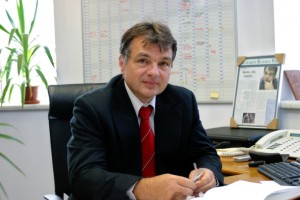 Volksbank Romania is looking to double its number of branches by the end of next year, while its parent company is scouting opportunities for large financing deals.
Volksbank Romania is looking to double its number of branches by the end of next year, while its parent company is scouting opportunities for large financing deals.
Growing interest from its existing German and Austrian clients in the Romanian market has prompted Investkredit to open a representative office in Bucharest later this year.
The bank, which shares the same owner as Volksbank, will be serving large corporates and offering sophisticated banking products, especially for multinational firms who are the clients of Investkredit in Germany, Poland and Austria.
Now the bank is in the process of establishing an office for marketing duties and arranging business contacts, especially in real estate. “In this sector the rep office will be the contact point to bring ideas back to Vienna, where lending will be possible,” Investkredit's executive director and head of department corporate lending Europe, Michael Smutny, tells The Diplomat. These will not be “vanilla products” and will include long and mid-term financing in industry and infrastructure. The bank has no existing plans to offer full banking services.
Volksbank Romania will be a complementary partner, dealing more with the retail aspect and day-to-day business banking for micro, small and medium enterprises.
Currently operating 25 branches nationwide, the bank has a share capital of 110.6 million Euro and posted a net profit of almost two million Euro at the end of June this year. “We will open two or three more branches by the end of December this year and an extra 25 next year,” says Laurentiu Mitrache, president of Volksbank Romania.
He says the bank's aim is to become a competitive bank in its market segment, mortgages, where it boasts a share of almost ten per cent.
Mitrache feels the banking sector in Romania has evolved faster than others in the local economy, “because of significant foreign investment in the field, as well as because of the central bank's efficient policy of allowing the banking system to develop steadily,” he says.
EASY LEASING
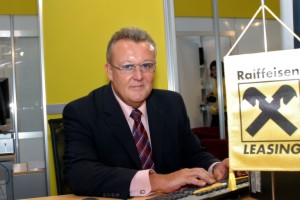 Operational leasing is still an untapped market for two of the major firms in this sector in Romania, both of whom are continuing a countrywide expansion strategy.
Operational leasing is still an untapped market for two of the major firms in this sector in Romania, both of whom are continuing a countrywide expansion strategy.
Operational leasing is where a leasing company hires out a product for a period of time, expecting it back from a client in a decent condition, so it can hire it out to someone else.
But dominating the market is financial leasing, where leasing companies buy products for customers, who then pay the firm for it in instalments, says Bernd Kunzel, general manager of Raiffeisen Leasing.
Established in 2002, Raiffeisen Leasing was last year's second largest leasing company in Romania and first in the ranking of bank-owned leasing firms. The company mainly provides financial leasing for car, equipment and real estate.
But that will change.
“The law from 1999 does not really define the terms for operational leasing,” says Kunzel, “but we have decided to start providing this service in the next two months.”
In 2004 the group's turnover (the purchase value of the goods leased) was 117 million Euro, up from 54 million Euro in the previous year. In 2005 this will approach 130-135 million Euro.
Present in 16 cities, the leasing firm plans to expand to another 25 of Raiffeisen bank's locations.
Meanwhile Volksbank Leasing Romania has just announced new leasing contracts with a value totalling around 80 million Euro for the first nine months of this year, compared to 50 million Euro for 2004.
“We expect that by the end of this year we will exceed 100 million Euro in new contracts, more than double compared to 2004,” says administrator Michael Unterguggenberger.
The total amount of financing VB Leasing granted to its more than 17,000 clients since it entered the Romanian market exceeds 300 million Euro.
Car leasing takes the main share of the business, with 60 per cent of all financing, 30 per cent goes to transport and construction and ten per cent on industrial equipment.
VB Leasing operates in Bucharest, Timisoara, Cluj-Napoca, Constanta, Iasi, Brasov and Craiova and, by the end of this year, will open in Sibiu. Galati and Oradea are planned for the first quarter of 2006.
DAMAGE LIMITATION
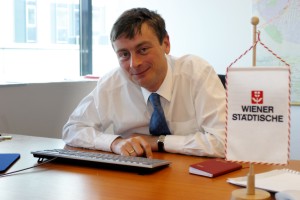 Group Wiener Staedtische, now the second largest player in the central and eastern European insurance market, leads the Romanian insurance market with a market share of 20 per cent. In Romania it owns the brands Unita, Agras and recently Omniasig.
Group Wiener Staedtische, now the second largest player in the central and eastern European insurance market, leads the Romanian insurance market with a market share of 20 per cent. In Romania it owns the brands Unita, Agras and recently Omniasig.
Wiener Staedtische's strategy for its branches abroad is to rely on local management and keep their original identity.
“It is not, for example, like McDonald's or Coca Cola or even Raiffeisen. A well known and well established brand is to be kept,” Hannes Fahrnberger, executive director of Unita Wiener Staedtische tells The Diplomat.
“We also invest the money we earn in the country where we are, we don't take the money and carry it to Austria,” Fahrnberger adds.
This August, Wiener Staedtische bought 72.8 per cent of the insurance company Omniasig from THIB Holding. The remainder is held by Banca Comerciala Romana Group and private investors. “Benefiting from the Wiener Staedtische support, our position on the Romanian [insurance] market will consolidate,” says Constantin Toma, president and general manager of Omniasig.
Wiener Staedtische's strategy for Omniasig is to focus mainly on the corporate segment, but also in products for retail and to individuals. House insurance represents 13.7 per cent of its portfolio. In the months July to October this year the company received 155 requests following this year's serious floods and the total value of the paid damages is nearly 400,000 Euro.
In 2001 Wiener Staedtische bought 51 per cent of Unita's shares and the following year increased its ownership to 99.99 per cent. Unita is, according to Fahrnberger, “the fastest growing insurance company on the Romanian market”, with a growth ratio of 94 per cent in the first half of this year - a turnover of almost 40 million Euro compared to last year's 20.6 million Euro.
The company offers life to non-life insurance, aimed mainly at individuals. In the group's strategy, Unita will pass its life insurance portfolio to Omniasig, as this is part of the latter's expertise, under the banner of Omniasig Asigurare de Viata.
Agras, meanwhile, passes its non-agricultural portfolio to Unita, in order to become “a small, highly profitable, focused agricultural insurer”, according to Fahrnberger.
Established in 1992, Agras is Romania's biggest agricultural insurance company, half of its portfolio is in agricultural insurance policies, such as hail and windstorm insurance policies and other non-life insurance products such as household insurances.
As for the yet undeveloped private pension market, Dan Odobescu, Unita Wiener Staedtische president and CEO tells The Diplomat that what they, as an insurance company, expect from the legal frame (which is still in gestation) is to allow only big, well established insurance companies to offer private pensions. He thinks that allowing smaller insurance companies to offer private pensions as well “could open the door to fraud”.
Following the floods, the Government also called for compulsory house insurance to happen in 2006.
“This is much ado about nothing,” says Odobescu. “I think [this project] will never become reality. Compulsory house insurances are an anti-constitutional piece of nonsense.”
Meanwhile Grawe Romania has a market share of around four per cent in the insurance market, thanks to its acquisition this year of local insurance company Sara Merkur. In the period April to September this year, Grawe Romania thus raised its premiums by about 70 per cent.
Peter Kasyk, general director of Grawe Romania tells The Diplomat that the Romanian legal frame for the insurance market is becoming “more and more European”, but Romanians' attitude towards insurance products is still not fully ripe. The younger generation, though, is more open to the necessity of having insurance, whereas the older generation is not as interested.
The Romanian mentality will not experience a very abrupt change after Romania's European integration either, according to Kasyk.
Grawe Romania will begin offering private health insurance by the beginning of next year, but the precise nature of the this new insurance product is still to be established. Private health insurance in Romania is likely, in its first period, to be accessible mainly to the people with medium and high incomes.
BUILDING STRONGER TIES
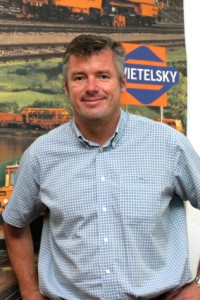 One of the most backward developments in Romania is in its transport infrastructure. But with the road and rail Pan-European Corridor IV crossing Romania from west to east, work needs to start quickly. One such example is Swietelsky Constructii Feroviare, a subsidiary of Swietelsky Baugesellschaft Austria.
One of the most backward developments in Romania is in its transport infrastructure. But with the road and rail Pan-European Corridor IV crossing Romania from west to east, work needs to start quickly. One such example is Swietelsky Constructii Feroviare, a subsidiary of Swietelsky Baugesellschaft Austria.
Present in Romania since 2003 mainly in the transport sector and in building railways, the company has already worked on the 143.9 million Euro project to rehabilitate the Bucharest-Campina railway section of Corridor IV and looks set to further leave its mark on the development of Romanian rail.
“Swietelsky plans to take part in two more tenders, for the rails linking Fundulea to Fetesti and Fetesti to Constanta, each project estimated to cost in the range of 200 million Euro,” Helmut Schreiner, director at Swietelsky Constructii Feroviare, tells The Diplomat.
The company is also involved in rehabilitation of the underground system in Bucharest, tram rails for the capital's transport utility RATB and a renewal of Chitila's railway station and rails.
Its annual turnover stands at about five million Euro in Romania.
Meanwhile, construction material firm Baumit is capitalising on a strong position in Romania and has dug in its investment this year through building a ten million Euro greenfield plant for dry mortar in Teius, Alba county.
“This is the biggest project this year,” general manager Laurentiu Lupusor tells The Diplomat.
Lupusor says Baumit plans to pursue similar investments in the next five years, with possible locations being in northern Moldavia.
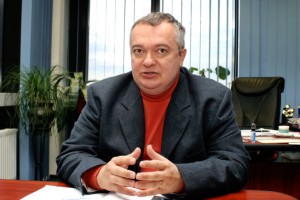 In addition to the Teius plant, the company is modernising its dying and mortar plant in Bucharest and has opened a new warehouse in Bacau.
In addition to the Teius plant, the company is modernising its dying and mortar plant in Bucharest and has opened a new warehouse in Bacau.
Baumit is part of international construction material concern Schmid Industrie Holding and has invested 15 million Euro in Romania so far.
The Teius plant is Baumit's second production facility in Romania, after Bucharest, and boasts an annual production capacity of 200,000 tonnes.
“The market is constantly growing to the point at which the demand is bigger than what we can offer,” says Lupusor. “The Bucharest facility is at this moment full, so we are looking towards finding new locations to construct plants.”
PUBLIC PARTNER,
PRIVATE CONCERN
Starting out in Romania in 1994 as an exclusive partner of Hewlett Packard on service and sales, S&T since expanded into a diverse range of IT projects for large private and public institutions, as well as adopting an acquisition strategy.
“When HP set up its representative office here, we decided to diversify our range of partnerships,” Florin Fagarasan, marketing and business development director tells The Diplomat.
Major local projects include supplying the IT infrastructure for Romania's Passport Service (almost 4.5 million Euro) and the implementation of a two million Euro ERP system at Mittal Steel, Galati. It is also involved in the IT system for the National Pension System.
“Romania is a mature market which does not lack any important name,” says Fagarasan of the IT sector. “Its main problem is that it is more mature than other industries in Romania.”
S&T Romania has contributed the most to the annual turnover of the group, which is present in 21 countries, in the past two years. “There is also the intention to tackle the US market,” adds Fagarasan.
Celebrating a century on the market, Siemens in Romania is capitalising on increased national presence, with Cluj-Napoca witnessing special attention from the Austrian company.
The company recently opened a new regional office in the city, after a similar endeavour in Timisoara. This aims to promote Siemens activity in areas such as medical equipment, automation and fixed telecom. In the future other divisions of the Siemens Romania group will be represented there.
REGIONAL FLYER
It may be a high flyer, but not a new contender, as Austrian Airlines began flights to Bucharest back in 1959. Half a century later the carrier services four local cities, Bucharest, Timisoara, Cluj-Napoca and Sibiu, and is looking towards expanding its reach further.
“No other EU carrier serves so many destinations as we do in central and eastern Europe,” says Johann Jurceka, deputy vice president on corporate and market communications at Austrian.
Wolfgang Groeger, country manager for Romania and Moldova adds: “We started operating from Sibiu in May this year, five times per week, and at the same time we are still trying in other cities, like Constanta, where we did joint market research with Tarom.”
Groeger says about two years ago the airline did similar research on Iasi, and the results were positive.
Now flights from Constanta and Iasi depend on traffic rights, a bilateral agreement which says that half of the flight is carried out by the national carrier and the remainder by the other airline.
“Until the Open Sky agreement will come into force once Romania gets to the EU, we will continue our very good cooperation with Tarom,” says Groeger.
SUPERMARKET SWEEP
Part of the Rewe Group, general supermarket Billa Romania has 16 stores all over the country, four others under construction in Satu Mare, Braila, Bacau and Ramnicu Valcea and a plan to open another ten next year.
By 2009, 60 locations are sought after, says Wolfgang Janisch, general manager for Billa Romania.
Each store costs 3.5 to four million Euro and the Austrian company has invested around 50 million Euro in Romania so far.
There is a difference in the retail market in Romania and central Europe, with Janisch, with buying power less than other new European Union countries, but more developed than Bulgaria. But investors, he says, could overestimate the buying power of Romanians.
After EU accession, supermarkets will see an improvement for customers. “Then Romanians will be able to buy oranges from Sicily in the winter and not only from Turkey,” he says.
SUGAR RUSH
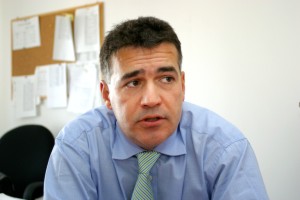 Austrian sugar producer Agrana entered the market in 1998 and now owns three sugar factories in Tandarei, Buzau and Roman, a production unit for starch and glucose at Tandarei and two production and processing units for fruit in Vaslui and Carei. In addition, the company owns Roman Aprod which produces chocolate, sweets and Turkish delight for the Romanian market.
Austrian sugar producer Agrana entered the market in 1998 and now owns three sugar factories in Tandarei, Buzau and Roman, a production unit for starch and glucose at Tandarei and two production and processing units for fruit in Vaslui and Carei. In addition, the company owns Roman Aprod which produces chocolate, sweets and Turkish delight for the Romanian market.
Based on the same model as Austrian sugar brand Wiener Zuker, Agrana launched Margaritar in a paper packaging for a mass market.
This was an exercise, says general manager Agrana Romania Emilian Dobrescu, which did not quite turn out as predicted.
“Margaritar itself created a quality sugar brand,” he says. “Sales were not so good because people associated it with a high price. And that was the wrong idea.”
In response, the firm launched a more mass market brand, Coronita, which differentiated itself by using plastic packaging.
The result? Coronita recorded massive sales.
Its parent company is now the market leader in sugar.
Romanians, Dobrescu says, are price-conscious. It seems that if a product has a perceived premium value it will not attract mass consumers.
As well as producing white sugar for retail and industrial use (for brands such as Coca Cola). Agrana imports brown, cubic and icing sugar from Wiener Zuker.
The Austrian company has invested 60 million Euro in Romania, excluding the cash paid for the factories.
In spice, Kotanyi, with a rep office in Romania, intends next year to enlarge its distribution to a higher level, general manager Liliana Homocea tells The Diplomat.
“The Romanian spice market is fast developing,” says Homogea. “The consumer is not stable and migrates from one producer to another. But on the other hand it has started to differentiate between brands.”
Now selling 80 products locally, Kotanyi claims to have been the first company to bring in saffron, a spice reputedly worth more for its weight than gold.
DRIVE BUY
Established locally in 1993 as the authorised importer of Fiat and Alfa Romeo in Romania, Auto Italia has now branched out to assist in importing 4x4 vehicles from SsangYong, Maserati and Honda motorcycles and is in discussions to bring Ferrari on the Romanian market, according to president Herbert Stein.
This year's target is over 6,500 units and plans for 2006 include sales of 7,500 cars. New model launches include Fiat Grande Punto, the New Fiat Croma and SsangYong Kyron.
“As a proof of confidence in the future of the Fiat Group, Auto Italia Group will invest over ten million Euro for the construction of a new auto mall on the motorway between Bucharest and Ploiesti,” says Stein. The construction, over 20,000 sqm, should be finished by the middle of 2007.
Stein says Auto Italia Group will develop a buyback business in the near future, but will not get into second hand car activity.
CLEAN BREAK
Cosmetics, detergents, adhesive and cleaning product firm Henkel is one of the market leaders in Romania and, although it runs production facilities in Poland, Hungary, Slovenia and Slovakia, there are no such plans for this country, says Liviu Sfrija, president of Henkel Romania. Consumption per Romanian habitant in terms of personal care products is at least 50 per cent less than new European Union countries.
Lack of purchasing power contributes to this. “About 95 per cent of Romanians have knowledge about detergents, but a lower percentage use them,” says Sfrija. In detergents, the Romanian market is atypical, because although people do not have a lot of money, the expensive detergent segment is huge. Sfrija believes people “underestimate” the market for male cosmetics. Especially as Romanian males like to wear aftershave daily. However they do not buy a lot of shampoo.
There is also a lack of skin products from Henkel's portfolio in Romania. But not for long. The company intends to bring premium moisteuriser Diadermine soon.